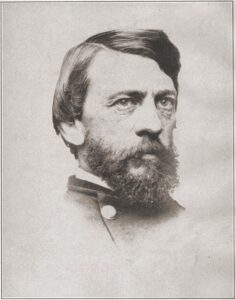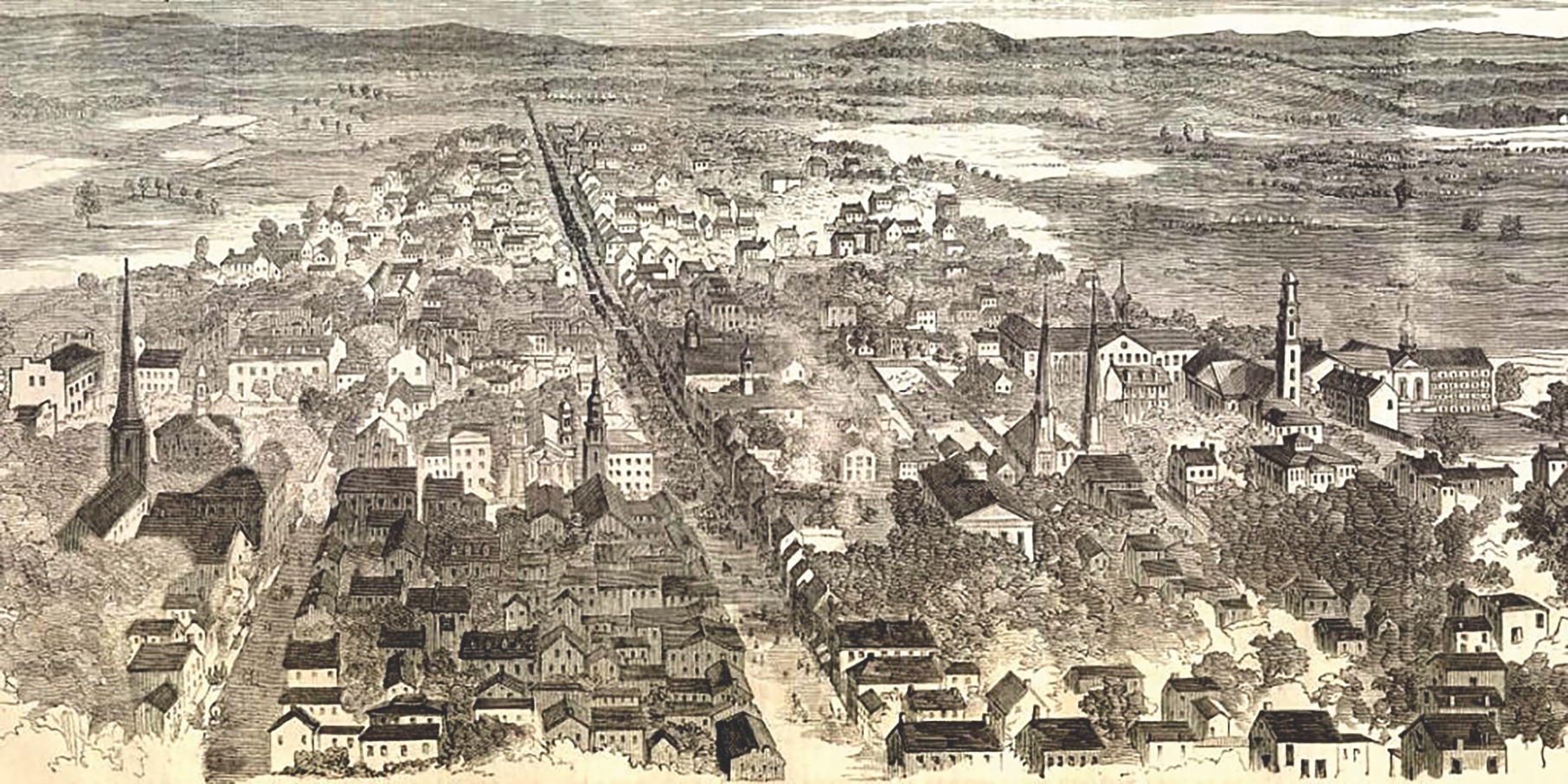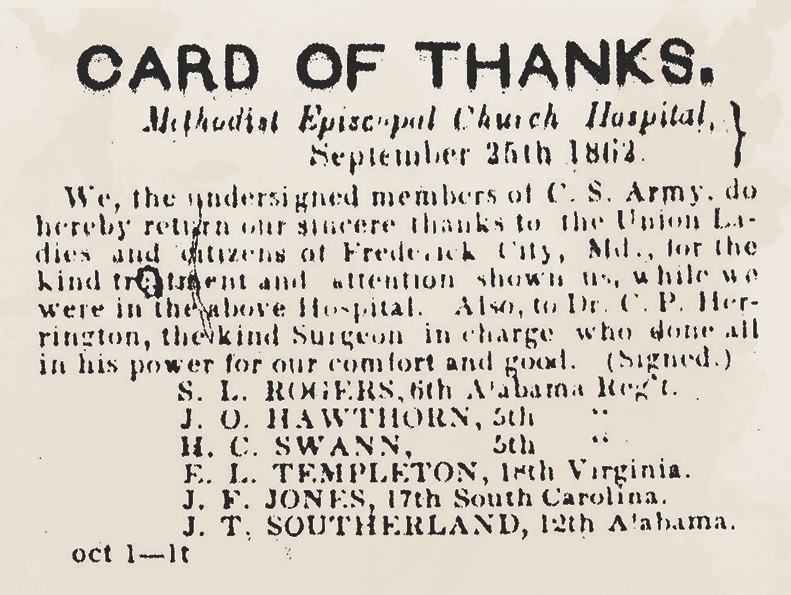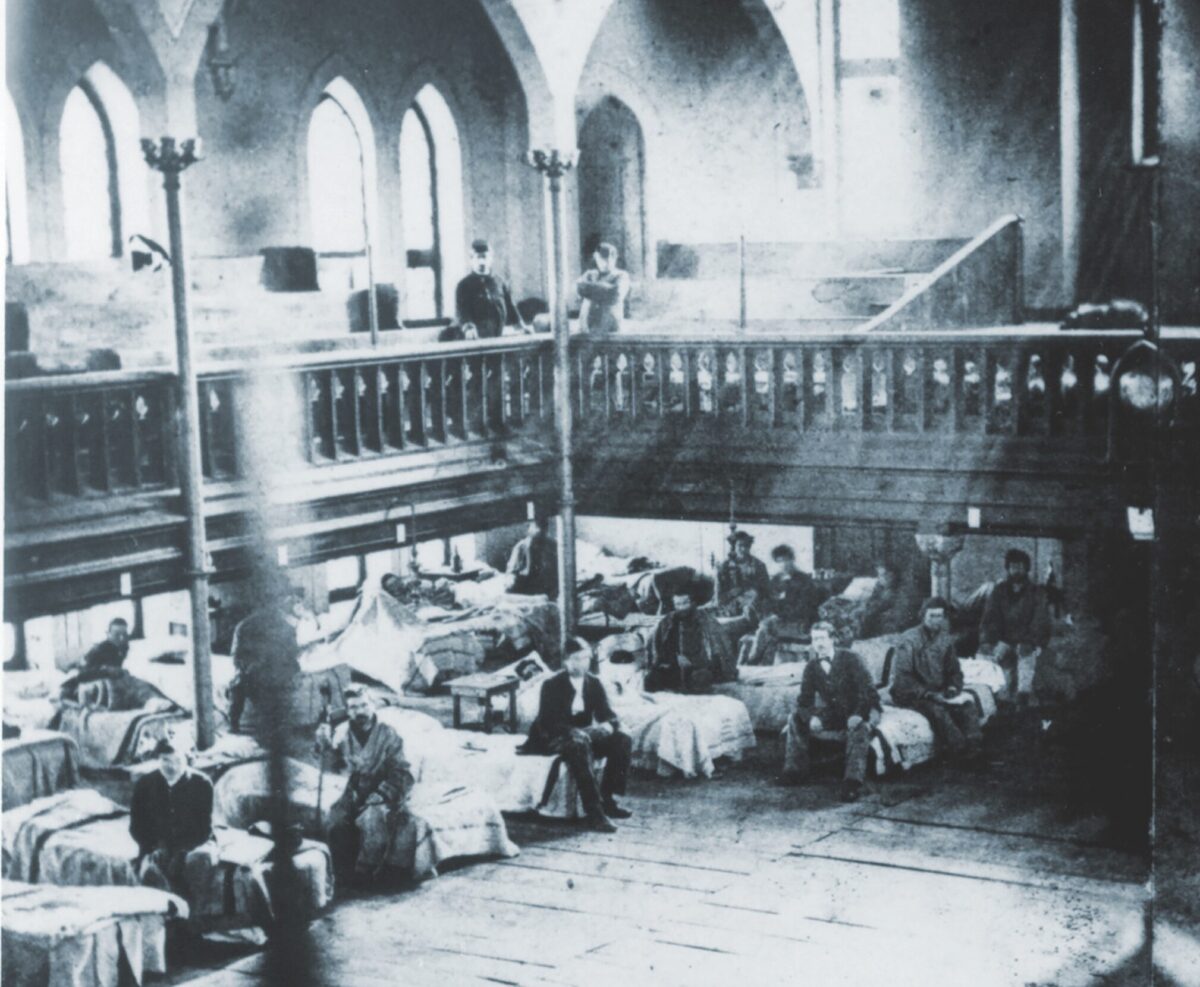“When we first came here the streets, on a pleasant afternoon, were filled with convalescent wounded soldiers,” Union soldier Stephen Bogardus Jr. wrote in a letter to his hometown newspaper in late January 1863. His unit, the Maryland-based Purnell Legion, was assigned to guard the important railhead and road junction at Frederick, Md.—assigned to the noncombat assignment in early December 1862.
Remembering his arrival in Frederick, Bogardus wrote of the numerous wounded men he witnessed everywhere in the town of 8,000 residents. “The bandaged head, the empty sleeve, and the stump of a leg, told a tale louder than words could speak,” he continued in his letter to the Poughkeepsie Daily Eagle. “Those who spoke flippantly of patriotism as a mere word should have seen some of those that I have met.”
The convalescing men that Bogardus met on the streets of Frederick were just a few of the thousands still beginning their recovery from serious wounds and illnesses following the bloody fighting of September 1862. In the chaotic battles atop South Mountain and along Antietam Creek, more than 20,000 American soldiers fell wounded. Many were destined for makeshift hospital wards inside Frederick’s public buildings, churches, schools, and hotels.
An incredible transformation took place in Frederick in the autumn of 1862. In the normally prosperous market community of local farmers and industrialists, almost all business had ground to a halt. Life in Frederick had been disrupted since early September, when the Army of Northern Virginia marched into town. Their occupation, lasting nearly a week, had summoned the Army of the Potomac from Washington, D.C. The Union army would occupy Frederick on September 12.
Arriving among the officer corps of the Union force was Major Jonathan Letterman, the Army of the Potomac’s 37-year-old medical director. Letterman had a monumental task ahead of him as the army moved into Maryland. He and his department were responsible for the health of more than 80,000 soldiers.

As Letterman entered Frederick on September 13, he ordered “the establishment of hospitals…for the reception of wounded in the anticipated battles.” The directive to prestage medical supplies and personnel prior to the outbreak of fighting was indeed revolutionary and heralded a series of other innovative steps Letterman would take while in command of the Army of the Potomac’s medical wing. The major, in fact, had begun a complete overhaul of the army’s Medical Department.
In what has become known as “The Letterman Plan,” he oversaw the reorganization of battlefield medical evacuation from the moment that soldiers were wounded on the front lines, to the care they received at field hospitals, and then at more established medical facilities away from the battlefield in communities such as Frederick.
As part of his new system, Letterman seized control of the army’s ambulances and conveyed them to the Medical Department and organized training for stretcher-bearers and ambulance drivers. He also enforced a new division-level field hospital system that ensured adequate medical supplies and personnel were available to treat the wounded.
Frederick, roughly 25 miles east of Sharpsburg, was to play a pivotal role in Letterman’s first field test of his new medical systems. Soon after Letterman issued his orders to convert it to a hospital city, significant quantities of beds, bandages, anesthetic, and other medical necessities began arriving. “All the churches (or nearly so) in Frederick have been taken for hospitals for the wounded which are to be brought to town,” wrote tailor Jacob Engelbrecht the morning of September 16.
According to Engelbrecht and other residents, the first wounded from the September 14 Battle of South Mountain arrived in Frederick aboard Army ambulances on the 17th. Engelbrecht counted the arrival of 25 ambulances filled with wounded and recorded that the churches-turned-hospitals were being rapidly filled.
The September 17 fighting at Antietam only added to the length of the ambulance trains winding their way to Frederick. In his after-action report, Letterman acknowledged the many challenges that needed to be managed:
All the available buildings in this city (six in number) were taken at once for hospitals for our own troops and those of the enemy who should fall into our hands. These were fitted up with great rapidity…the buildings selected and prepared, beds, bedding, dressings, stores, food, cooking arrangements made, surgeons, stewards, cooks, and nurses detailed and sent for. This was a great deal of labor, but it was done, and done promptly and well.
Among the first patients to arrive from the fighting in Maryland was Sergeant Henry Tisdale of the 35th Massachusetts Infantry. Tisdale had been shot through the left leg by a Minié ball at the Battle of South Mountain. After the ordeal on the mountainside, Tisdale found his way to a Union field hospital and was among the hundreds sent by ambulance to Frederick.
Decades later, a woman remembered these childhood moments, writing: “I can recall standing on Market Street…and how we used to watch the wagons bringing the wounded into Frederick for us to look after. There was so much blood dripped out of the back of the wagons and falling on the dirt road, that eventually the mud became red as the wagon wheels ploughed through the streets.”

Medical authorities placed Tisdale and others suffering as he was into the makeshift hospital ward at the Evangelical Lutheran Church on East Church Street. Tisdale later described what he witnessed inside:
A rough board floor was laid over the tops of the pews. Folding iron bedsteads with mattresses, clean white sheets, pillows, blankets, and clean underclothing, hospital dressing gowns, slippers, etc. were furnished us freely. The citizens came in twice a day with a host of luxuries, cordials, etc. for our comfort. The church finely finished off within, well ventilated and our situation as pleasant and comfortable as could be made.
By September 30, Frederick’s makeshift hospital wards already had more than 2,321 patients, and there were 3,032 patients in two tent hospitals set up on the outskirts of the city—with 62 surgeons, 15 medical cadets, 22 hospital stewards, 539 nurses, and 127 cooks on duty, according to Letterman.
For the town’s residents, Letterman’s medical revolution prompted major changes to everyday life. “Town in commotion,” Engelbrecht recorded in his diary on September 23. “Our little city is all day long & part of the night one continued bustle of moving of wagons, ambulances, etc. bring wounded, medical & hospital stores.”
While residents observed the commotion suddenly enveloping their community, others jumped into action. “As a vast number of sick and wounded are now in our midst requiring immediate relief,” wrote Mrs. J.A. Bantz, president of the city’s Ladies’ Union Relief Association, “we would urgently entreat one and all of the friends of the cause, to renew their diligence and forward whatever they can…as our brave soldiers’ wants should be punctually attended to.”
Southern sympathizers also jumped into action for the wounded Confederates cared for in the city’s various hospitals. Catherine Markell attended them on numerous occasions, recording the visits in her diary and remarking sadly when soldiers died from wounds, infection, or disease. On November 24, she visited the Lutheran Church Hospital on Church Street before heading on to Mount Olivet Cemetery. “[P]laced flowers on the graves of our friends of CSA who are buried there,” she wrote somberly.
Despite the bleak situation as the weather turned cold in October and November, Frederick residents received high praise for their heroic actions in assisting the wounded in the city now labeled as “one vast hospital” by the Philadelphia Inquirer. One of those lavishing praise on Fredericktonians was a Baltimore preacher who wrote that, “the inhabitants of that city have covered themselves with a glory high above that of military conquerors, by their noble charities.”

All the while, Frederick residents dealt with the noise of wounded soldiers, the illicit activities of those convalescing soldiers who were mobile enough to visit the city’s beer halls, and the ever-present Union military occupation. “Everything from the omni-presence of the soldier is tinged with blue,” one Pennsylvania soldier wrote in his diary. “Officers and privates crowd the sidewalk.” The intrusions of military and hospital into civilian life meant that for months everyday life in the community came to a halt.
Over the course of four months between September 1862 and January 1863, U.S. Army surgeons recorded the treatment of more than 8,000 patients in Frederick’s hospitals—in effect doubling the size of the city’s population. The life-saving care given in the city’s schools, churches, hotels, and private homes could not have been administered without the assistance of the local residents who nursed the wounded and amassed supplies despite the horrors of war.
Wounded were removed from the city’s public spaces in early 1863 and moved to general hospitals in neighboring communities for further recovery—the next step in Letterman’s system of care. Many of the treated, including Confederates, would forever remember the assistance of locals who volunteered at their bedsides.
The efforts of Letterman, the surgeons, and the heroic civilians of Frederick all played a role in revolutionizing medical care and inventing the system of emergency evacuation as we know it. The National Museum of Civil War Medicine welcomes visitors to experience the town’s key part in the development of these vital systems we rely upon today.
Jake Wynn is Director of Interpretation at the National Museum of Civil War Medicine and Clara Barton Missing Soldiers Office. John Lustrea is the National Museum of Civil War Medicine’s Education Coordinator.





